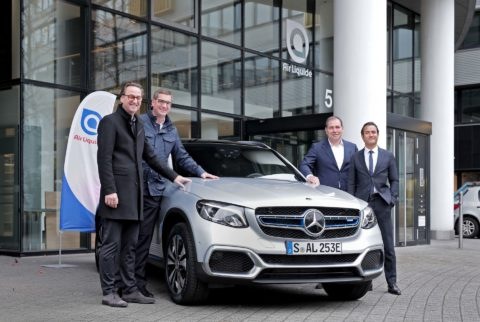Mercedes-Benz has started deliveries of what they are calling the world’s First FCEV Plug-in hybrid, based on the Mercedes Benz GLC SUV. As of now, Mercedes-Benz in focusing deliveries for cities in Germany that have access to Hydrogen pumping stations and some select business, customers in cities like Stuttgart and Hamburg can opt for the car under the Mercedes-Benz Rent program and avail of short term and long term rental plans from the spring of 2019. Other GLC F-Cell’s will be supplied to regional ministries and organisations like Air Liquide, Shell, Linde AG with immediate effect.
What sets the Mercedes-Benz GLC F-Cell apart from the remaining host of Mercedes cars, is the fact that it runs on both electricity and can also use pure hydrogen to run its electric motors. Mercedes say that it is this duality of nature that sets the GLC apart from the rest of the pack of Fuel Cell and Electric cars. Since short range charging of the battery allows for a considerable range for daily use, the addition 4.4 kg tank of hydrogen in the vehicle floor pan allows for excellent long distance range. Courtesy the globally standardised 700-bar hydrogen tank technology, the hydrogen supply can be replenished within just three minutes – as quickly as is customary when refuelling a combustion-engined car. On pure hydrogen mode, the F-Cell delivers an exceptional range of 430kms based on the more rigid NEDC cycle, but the GLC can also go a full 51 kms in pure electric mode. It won’t be humdrum to drive either, with the GLC boasting 207 hp from its electric motor, more than enough to keep it from being mild. Mercedes-Benz also claims that the GLC F-Cell uses both zero-emission drive technologies intelligently thanks to an operating strategy, that continuously optimises the use of both energy sources in line with the current operating situation.
Mercedes-Benz’s GLC F-Cell has 4 operating modes:
Hybrid: This uses both energy source in tandem, drawing power boosts from the battery and using the FC for optimal efficiency.
F-CELL mode: The Fuel Cell continually charges the battery keeping energy constant, the only hydrogen is consumed in this process.
BATTERY: the GLC F-CELL runs all-electrically and is powered by the high-voltage battery. The fuel cell system is not in operation. This is the ideal mode for short distances.
CHARGE: charging the high-voltage battery has priority, for example in order to recharge the battery for the maximum overall range prior to refuelling with hydrogen or to create power reserves.
The GLC F-Cell features energy recovery in all modes, which charges the battery under braking or coasting, to recharge the battery.
